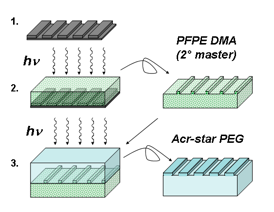
So far we have mainly worked with two distinctly different biomaterials; a very hydrophilic hydrogel and a very hydrophobic fluoropolymer. The elastomers are prepared from prepolymers that are crosslinked by UV-curing.
The star PEG-based hydrogels are characterised by their ability to take up water and swollen gels may contain more than 90% water. Their mechanical properties can be tuned by varying the crosslinking density, and due to their softness and high water content these hydrogels closely resemble living tissue. Combined with their cytocompatiblity, these materials are excellent biomaterials.
The PFPE-based fluoropolymer is also an interesting biomaterial, e. g. for biomedical implants, since it doesn’t swell in water, is inert to chemical degradation and is both hydrophobic and oleophobic. Based on these properties, undesired protein adsorption and adhesion of unwanted cells is suppressed.
Nevertheless, specific topographic patterns or a certain roughness yields superhydrophobic materials on which the biointeraction may be different from that on the smooth elastomer.
Besides the potential bioapplications of this material, the fluoropolymer is an excellent material for soft (nano)lithography, e. g. in replica molding.
Besides these two diametrically opposed (bio)materials we are also interested to develop new biomaterials, such as biodegradable ones for tissue engineering purposes.
Development of novel biomaterials


